The Muleteers of Vivarais in Upper Ardèche |

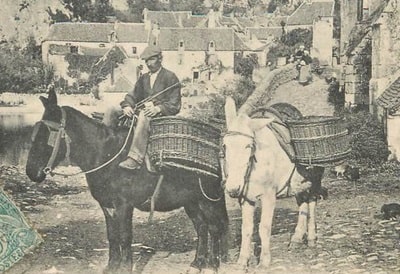 Coming from the Cévennes slopes of Mont Mézenc to Mont Lozère, the muleteers had a solid reputation. Their villages included St. Étienne de Lugdarès, Montselgues, Loubaresse, St. Laurent les Bains, and St. Cirq en Montagne. In the Cévennes, being a muleteer was a title, an honor, a source of pride.
Coming from the Cévennes slopes of Mont Mézenc to Mont Lozère, the muleteers had a solid reputation. Their villages included St. Étienne de Lugdarès, Montselgues, Loubaresse, St. Laurent les Bains, and St. Cirq en Montagne. In the Cévennes, being a muleteer was a title, an honor, a source of pride.
There was a time when paved roads did not exist, rivers were insurmountable obstacles, and mountains served as natural borders. It was a time when mules were the kings of the roads, loyal companions of the muleteers, and essential actors in trade and exchanges. It was a time when mule tracks crisscrossed Vivarais and Velay, connecting valleys and plateaus, villages and towns, regions and provinces.
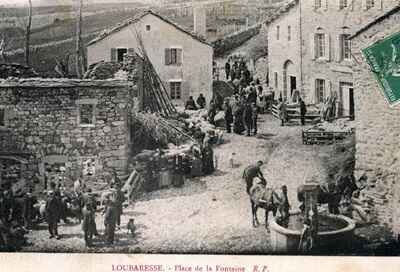 These mule tracks, traced along the ridges, followed the contours of the terrain, avoided marshy areas, crossed passes and bridges. They were real arteries of commerce, used by convoys of mules loaded with various goods. They still testify today to the history, culture, and heritage of these territories.
These mule tracks, traced along the ridges, followed the contours of the terrain, avoided marshy areas, crossed passes and bridges. They were real arteries of commerce, used by convoys of mules loaded with various goods. They still testify today to the history, culture, and heritage of these territories.
The muleteers had well-defined specialties and routes. Some transported wine from Lower Vivarais and the banks of the Rhône to the highlands of Auvergne, where vines could not grow. Others carried salt from the Mediterranean saltworks and silk from Aubenas to Saint Étienne, the manufacturing center. Still others brought cereals, legumes, barley, and lentils from Puy-en-Velay, cultivated on the fertile lands of Velay.
Transhumance routes called drailles were also used, allowing flocks of sheep and goats to reach summer or winter pastures. The most famous was the Regordane, connecting Nîmes, Alès, Villefort, La Bastide-Puylaurent, Langogne, and Le Puy-en-Velay. It was used by pilgrims, Crusaders, merchants, and shepherds.
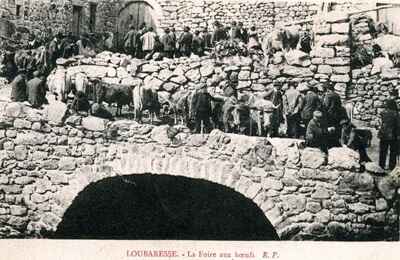 The importance of the Puy muleteers' trade has been known since the 16th century. The muleteers from Puy came from villages on the slopes of Mont Mézenc, Monastier, Montpezat (in Vivarais), and Arlempdes. They formed a powerful and respected guild, enjoying privileges and franchises. They were wealthy and prosperous, as evidenced by the price of a pair of mules at the time: 500 livres, the equivalent of a handsome city house.
The importance of the Puy muleteers' trade has been known since the 16th century. The muleteers from Puy came from villages on the slopes of Mont Mézenc, Monastier, Montpezat (in Vivarais), and Arlempdes. They formed a powerful and respected guild, enjoying privileges and franchises. They were wealthy and prosperous, as evidenced by the price of a pair of mules at the time: 500 livres, the equivalent of a handsome city house.
During crises, mules played an important role, especially in convoys led by civilians and in essential supply missions. But in times of peace, mules and muleteers were called upon for noble causes, such as during the famine in Velay in 1694, when multiple convoys were organized to transport necessary grain from the Rhône.
 According to Albin Mazon's work, the muleteer wore a red wool cap with a felt hat depending on the season, with hair tied at the back, ears adorned with gold rings from which a mule iron hung, a tie, and a red waistcoat, metal-shod shoes, a red wool belt with a decorated silver cup (to taste the merchandise), and a trocart (knife for piercing animal skins). In rainy weather, he wore a mountain cloak called a cape or limousine.
According to Albin Mazon's work, the muleteer wore a red wool cap with a felt hat depending on the season, with hair tied at the back, ears adorned with gold rings from which a mule iron hung, a tie, and a red waistcoat, metal-shod shoes, a red wool belt with a decorated silver cup (to taste the merchandise), and a trocart (knife for piercing animal skins). In rainy weather, he wore a mountain cloak called a cape or limousine.
The varlet was the "second" of the muleteer. He took care of the mules, prepared the loads, and supervised the convoy. He learned the trade by observing his master, listening to his advice, and imitating his gestures.
Mules were animals adapted to the terrain and climate, more resistant to fatigue than horses. They were crossbred between a mare and a donkey, or between a horse and a jenny. They were sturdy, obedient, intelligent, and loyal. They were carefully cared for by the muleteers, who considered them as members of their family.
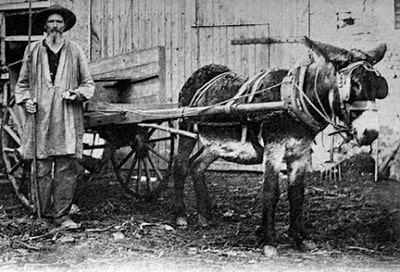 The leader of the mules was called the “Viei”: it was the strongest, proudest, and best harnessed. It led the convoy on foot, guiding the other mules by its example. It often wore ornaments, ribbons, feathers, and bells. Then came the “roulet”: it carried a bell as big as a balloon, which was used to alert the arrival of the convoy, scare away wolves, and set the pace. It was the most joyful, loudest, and mischievous. In the middle was the “bardot”: the offspring of a horse and an donkey, which was sterile. It carried the “rambail”: the contract or “pact” money, the agreement between the muleteer and the merchant. It also carried the “ferrière”: a toolbox containing the necessary tools to repair harnesses, bottles, and shoes.
The leader of the mules was called the “Viei”: it was the strongest, proudest, and best harnessed. It led the convoy on foot, guiding the other mules by its example. It often wore ornaments, ribbons, feathers, and bells. Then came the “roulet”: it carried a bell as big as a balloon, which was used to alert the arrival of the convoy, scare away wolves, and set the pace. It was the most joyful, loudest, and mischievous. In the middle was the “bardot”: the offspring of a horse and an donkey, which was sterile. It carried the “rambail”: the contract or “pact” money, the agreement between the muleteer and the merchant. It also carried the “ferrière”: a toolbox containing the necessary tools to repair harnesses, bottles, and shoes.
The other mules were named according to their qualities: the calmest was tasked with carrying the “alte” around its neck—a glass bottle wrapped in straw, used for drinking during breaks. The fastest carried perishable goods such as cheese, butter, and fruits. The most agile was assigned to carry fragile items like crockery, glasses, and mirrors.
 One mule carried a load of 168 liters of wine in bottles: animal hides, cow or goat skins. The bottles were much easier to transport than barrels. They fit the shape of the animal’s back, did not break, and did not spill. They were sewn with hemp thread and coated with pitch to make them waterproof.
One mule carried a load of 168 liters of wine in bottles: animal hides, cow or goat skins. The bottles were much easier to transport than barrels. They fit the shape of the animal’s back, did not break, and did not spill. They were sewn with hemp thread and coated with pitch to make them waterproof.
Viticulture was important in Ardèche (it thrived as early as the 3rd century), with white wines like those from Largentière, Montréal, Vinezac, and light wines like Villeneuve de Berg already produced. Most of this production was transported on muleback to local markets or neighboring regions.
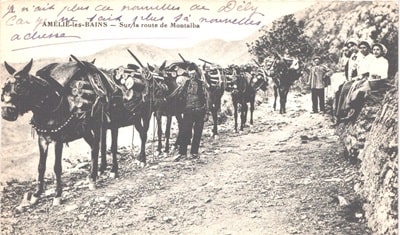 The passage of muleteers through villages or hamlets such as Loubaresse was always an event, often the only one! The muleteers announced their arrival from afar with jingling bells, enchanting children, who would repeat in chorus: balalin, balalan.
The passage of muleteers through villages or hamlets such as Loubaresse was always an event, often the only one! The muleteers announced their arrival from afar with jingling bells, enchanting children, who would repeat in chorus: balalin, balalan.
They ran to meet them, hoping to get sweets, coins, stories, or even a ride on the mules. The muleteers smiled, made jokes, sang ballads, or taught tricks to the children.
Peyre was an important mule station, where muleteers of all origins met, sometimes in large numbers, along with bathers returning or going to the renowned thermal baths of St. Laurent les Bains, known for its healing waters. Peyre offered travelers welcoming inns, diverse shops, and festive entertainment.
At the stages where the muleteers stayed, they were guests of the hosts, who received them with hospitality. Hearty meals were served, accompanied by local wine, tobacco was offered, and musical instruments were lent. They ate, drank, danced the bourrée, shared news, gossip, and legends. Then the muleteers slept fully dressed in the hay, after caring for and feeding their animals. The next morning, they loaded the animals again and set off, welcomed by grateful villagers.
Former holiday hotel with a garden along the Allier, L'Etoile Guest House is located in La Bastide-Puylaurent between Lozere, Ardeche, and the Cevennes in the mountains of Southern France. At the crossroads of GR®7, GR®70 Stevenson Path, GR®72, GR®700 Regordane Way, GR®470 Allier River springs and gorges, GRP® Cevenol, Ardechoise Mountains, Margeride. Numerous loop trails for hiking and one-day biking excursions. Ideal for a relaxing and hiking getaway.
Copyright©etoile.fr